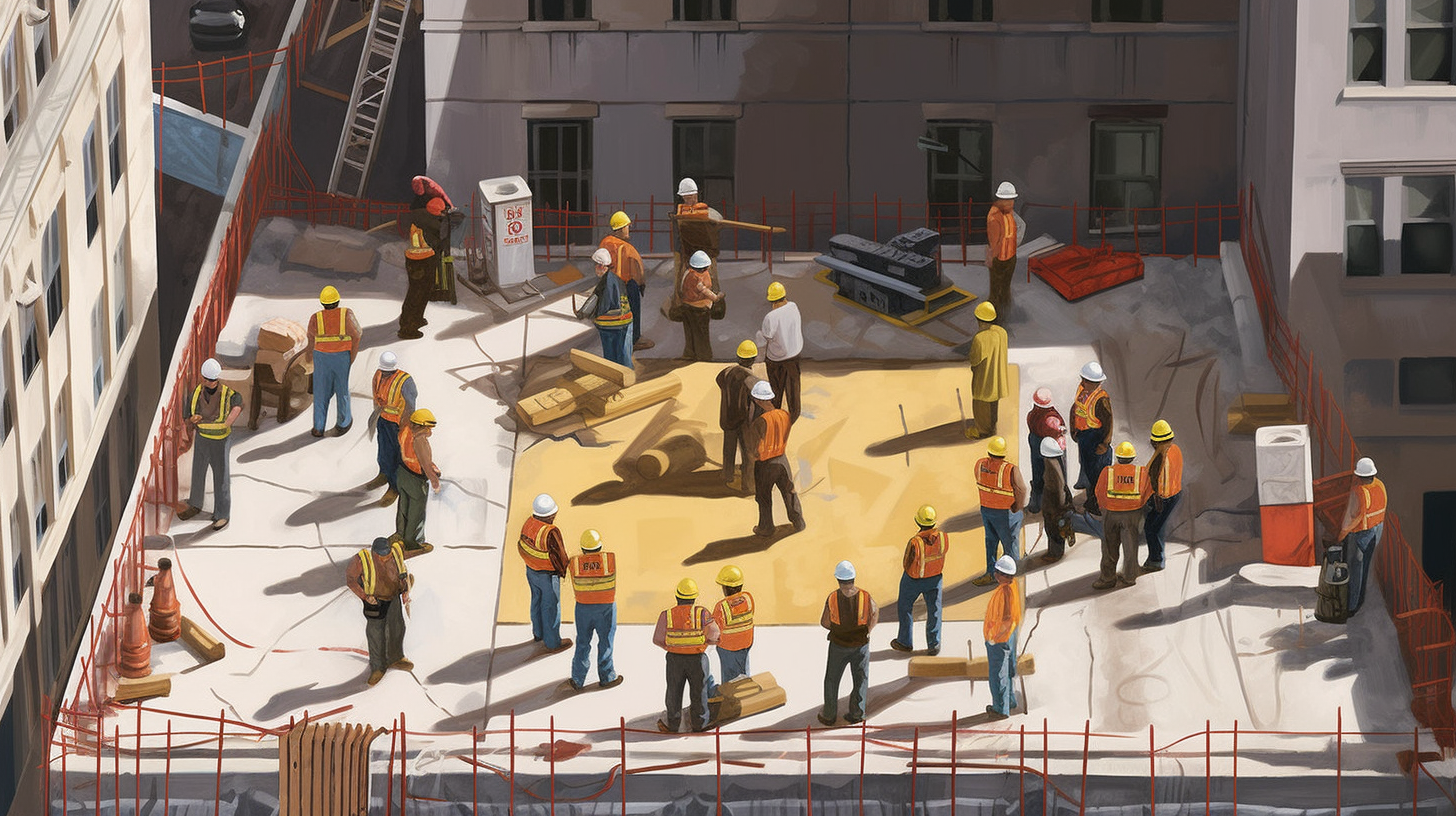You stand at the base of a towering government building, watching as workers scurry up and down ladders, hauling equipment and materials to the roof. As you look up at the dizzying heights above, your heart races with anxiety. You know that roofing work is inherently dangerous, and the risks are only amplified when it comes to government properties.
But as a responsible property owner, you also know that it’s your duty to ensure that the work is done safely and efficiently.
In this article, we will explore the importance of safety protocols and permits for roofing work in government properties, and how you can prioritize safety throughout the entire process. From conducting thorough risk assessments and providing personal protective equipment (PPE) to obtaining necessary permits and ensuring workers are aware of emergency procedures, we will cover everything you need to know to keep your workers safe and your property protected.
So let’s dive in and learn how to make safety a top priority when it comes to roofing work on government properties.
Conduct Thorough Risk Assessments and Hazard Identification
You can’t afford to skip on conducting thorough risk assessments and hazard identification if you want to ensure the safety of everyone involved in the roofing work.
Risk assessment techniques are important in identifying potential hazards and assessing the level of risk involved. There are various techniques that can be used such as checklists, flowcharts, and decision trees. These techniques help in identifying hazards that are not immediately apparent and may have been overlooked.
Hazard identification strategies are also crucial in ensuring safety in roofing work. This involves identifying potential sources of harm such as electrical hazards, falls, and exposure to harmful substances. Once identified, measures can be put in place to eliminate, control, or minimize the risk of harm.
These strategies should be reviewed regularly to ensure that they remain effective. By conducting thorough risk assessments and hazard identification, you can ensure that everyone involved in the roofing work is safe.
This leads to the next section on providing personal protective equipment (PPE) and proper training for workers.
Provide Personal Protective Equipment (PPE) and Proper Training for Workers
Make sure your workers have the proper PPE and receive adequate training to ensure their safety on the job. Providing personal protective equipment (PPE) is crucial in preventing injuries and accidents during roofing work.
PPE includes hard hats, safety glasses, gloves, and appropriate footwear. It is essential to ensure that the PPE provided is effective and appropriate for the job. For example, workers need to wear non-slip footwear to prevent falls from slippery roofs.
PPE effectiveness can be assessed by conducting regular inspections, checking for damage or signs of wear and tear. In addition, it’s important to provide proper training to workers on how to use PPE correctly. Workers need to know how to adjust and fit the equipment properly, as well as how to maintain and replace it when necessary.
Furthermore, a strong worker safety culture is essential to ensure that PPE is used correctly. This can be achieved by creating a culture of safety where workers are encouraged to speak up about safety concerns and are included in safety discussions.
Workers need to understand the importance of using PPE and how it can prevent injuries and accidents. Proper training and regular reminders can help keep safety at the forefront of the job. By prioritizing worker safety through proper PPE and training, you can prevent accidents and ensure a successful roofing project.
Ensuring workers are aware of emergency procedures and evacuation plans is crucial in the event of an accident or emergency.
Ensure Workers are Aware of Emergency Procedures and Evacuation Plans
As a responsible employer, you need to ensure that your workers are aware of emergency procedures and evacuation plans in case of any unforeseen events.
Developing effective emergency procedures and regularly reviewing and updating them is crucial to keeping your workers safe. You should also train your workers on these procedures to ensure that they know what to do in the event of an emergency.
By prioritizing emergency preparedness, you can ensure that your workers are able to respond quickly and effectively in case of any emergency situation.
Develop Emergency Procedures
When developing emergency procedures, it’s important to consider all possible scenarios and have a plan in place to ensure the safety of roofing workers and government property. This includes identifying potential hazards and outlining steps to take in the event of an emergency, such as severe weather, equipment failure, or accidents.
The emergency response plan should also include communication protocols, evacuation routes, and designated meeting areas. It’s critical to regularly review and update the emergency procedures to ensure they are effective and reflect any changes in the work environment.
All workers should be familiar with the emergency response plan and receive training on how to respond in case of an emergency. By prioritizing preparation and emergency response planning, you can help to minimize the risk of injury, property damage, and loss of life.
As you move forward with your safety protocols, the next step is to train workers on emergency procedures.
Train Workers on Emergency Procedures
You’ll love teaching your workers how to respond during emergencies! Emergency drills and safety simulations are crucial in preparing your team for unexpected situations. These exercises help workers understand the necessary steps to take during emergencies, including how to evacuate safely and communicate effectively with other team members and emergency responders.
Communication strategies are key in ensuring worker preparedness during emergencies. Make sure your workers understand the importance of clear communication during high-stress situations. Assign designated roles and responsibilities for each worker to ensure everyone knows what to do and who to turn to for guidance.
With regular training and practice, your team will be well-equipped to handle emergencies safely and efficiently. Remember, it’s crucial to regularly review and update emergency procedures and evacuation plans to ensure they remain effective and up-to-date.
Regularly Review and Update Emergency Procedures and Evacuation Plans
It’s important to regularly update and review emergency procedures and evacuation plans to ensure they’re effective and up-to-date. This ensures that all workers are informed and prepared for any emergency that may occur while working on government properties.
Here are three key reasons why you should prioritize regular reviews and updates:
- Changes in the property: Buildings and facilities may undergo renovations or updates that can impact emergency procedures. Regular reviews and updates will help ensure that all workers are aware of changes in the property that could affect their safety.
- Changes in laws and regulations: The government may change laws or regulations related to safety procedures, and it’s important to ensure that all workers are aware of these changes. Regular updates will help ensure that all workers are informed and complying with current standards.
- Evacuation drills and emergency response team training: Regular reviews and updates allow for the opportunity to practice evacuation drills and assess the effectiveness of emergency response team training. Practicing drills and assessing training is crucial to ensuring that workers can respond effectively in case of an emergency.
Regular reviews and updates of emergency procedures and evacuation plans are crucial in ensuring the safety of workers on government properties. Once these procedures are in place, the next step is to obtain necessary permits to ensure that all work is done in compliance with regulations and safety standards.
Obtain Necessary Permits
Before starting any roofing work on government properties, you need to obtain the necessary permits.
These permits include building permits, occupancy permits, and compliance with local regulations. It’s important to follow all regulations and requirements to ensure safety and avoid any legal issues.
Building Permits
Let’s talk about the importance of building permits when it comes to roofing work on government properties. Building permit requirements are in place to ensure that all construction work is done safely and up to code. As a roofing contractor, it’s crucial to navigate the permit application process to obtain the necessary permits before starting any roofing work on government properties.
When applying for a building permit, you’ll need to provide detailed plans and specifications for the roofing project. These plans should include information on the materials to be used, the scope of work, and any safety measures to be taken. It’s important to ensure that all aspects of the roofing project comply with local building codes and regulations.
Once the building permit is obtained, you can proceed with the roofing work, confident that it meets all safety standards.
Now that you have the building permit in place, it’s important to remember that it’s not the only permit you’ll need. The next step is to obtain an occupancy permit, which ensures that the building is safe and ready for use.
Keep in mind that safety is always the top priority when it comes to roofing work on government properties.
Occupancy Permits
Moving on from building permits, the next crucial document necessary for any roofing work in government properties is the occupancy permit. This permit is issued by the local government unit and serves as proof that the structure is fit for occupation. Obtaining this permit is imperative because it ensures that the building is safe for the people who will be using it.
To obtain an occupancy permit, you’ll need to undergo an inspection by the local government unit’s building inspector. The inspector will check if the structure meets the necessary safety standards and requirements set by the government. This inspection is crucial because it will determine if the building is safe for occupancy or not.
Here are some key points to keep in mind to emphasize the importance of obtaining an occupancy permit:
- An occupancy permit ensures that the building is safe for use and meets the necessary safety standards set by the government.
- Without an occupancy permit, you risk the safety of the people who will be using the building.
- The inspection requirements for obtaining an occupancy permit are strict and thorough, ensuring that the building is indeed safe for occupancy.
In the next section, we’ll discuss the importance of compliance with local regulations when it comes to roofing work in government properties.
Compliance with Local Regulations
It’s important to note that local regulations must be followed when undertaking roofing projects in government-owned buildings, and failure to comply can result in hefty fines or even legal action. Navigating regulations can be a daunting task, but it’s crucial to ensure compliance to prevent any legal or safety issues. Local regulations cover a wide range of topics, including building codes, safety protocols, and permit requirements.
To make the process easier, it’s recommended to research and familiarize yourself with the specific regulations in your area. Additionally, partnering with a knowledgeable roofing contractor who has experience working with government properties can provide valuable insight and guidance. By prioritizing compliance with local regulations, you can ensure a safe and successful roofing project. Moving forward, it’s important to continue prioritizing safety throughout the roofing work process.
| Local Regulations | Tips and Tricks |
|---|---|
| Research and familiarize yourself with specific regulations | Partner with a knowledgeable roofing contractor |
| Adhere to building codes, safety protocols, and permit requirements | Seek guidance from local authorities if unsure |
| Prioritize safety to prevent any legal or safety issues | Stay up-to-date on any changes or updates to regulations |
| Failure to comply can result in hefty fines or legal action |
Remember to always prioritize safety during the roofing project to ensure the well-being of all involved.
Prioritize Safety Throughout the Roofing Work Process
As you prioritize safety throughout the roofing work process, it’s crucial to regularly review and update safety protocols to ensure that your team is always up-to-date with the latest safety measures.
Providing ongoing training for workers is also essential to help them understand the importance of safety and to teach them how to recognize potential hazards.
Additionally, holding regular safety meetings and inspections can help identify potential safety issues early on. This allows you to take proactive steps to prevent accidents and injuries.
Regularly Review and Update Safety Protocols
To ensure maximum safety, we must constantly review and update our safety protocols for roofing work in government properties. The importance of communication and continuous improvement can’t be overstated when it comes to keeping workers and the public safe.
It is crucial to regularly review the protocols and ensure that they are up-to-date with current safety regulations and best practices. Safety protocols must be specific to the job site and the work being performed.
For roofing work, this may include using appropriate fall protection equipment, ensuring proper ventilation, and implementing measures to prevent heat-related illnesses. By continuously reviewing and updating our safety protocols, we can identify areas for improvement and make necessary changes to ensure that everyone involved in the roofing project is safe.
This ongoing effort is essential in providing ongoing training for workers, ensuring they have the most up-to-date safety information and procedures to perform their work safely.
Provide Ongoing Training for Workers
Providing ongoing training for workers is crucial in ensuring that they have the necessary skills and knowledge to perform their job safely. It’s the role of management to provide this training, which should cover a wide range of topics, such as proper use of equipment, fall prevention, and emergency procedures. The training should be tailored to the specific needs of the workers and should be interactive and engaging.
It’s important to recognize the importance of continuous learning in the roofing industry. Workers should be encouraged to attend seminars, workshops, and conferences to stay up-to-date with the latest safety protocols and techniques. By providing ongoing training, workers will be better equipped to perform their job safely, which will ultimately lead to a safer work environment.
This will help to reduce the risk of accidents and injuries, and ensure that the government properties are safe for everyone who uses them. As a result, it’s crucial to hold regular safety meetings and inspections to ensure that workers are following the safety protocols and to identify any potential hazards that may arise.
Hold Regular Safety Meetings and Inspections
You can elevate the level of safety in your workplace by regularly conducting meetings and inspections to ensure that all workers are following proper procedures and identifying any potential hazards. Effective communication is key in making these meetings and inspections successful.
Make sure to clearly communicate the purpose and agenda of the meeting, and encourage worker feedback to address any concerns or suggestions for improvement. To ensure continuous improvement, it is important to identify any implementation challenges that may arise during the meetings and inspections. This could include resistance from workers or lack of resources.
By addressing these challenges and finding solutions, you can create a safer work environment. Utilize the information gathered during the meetings and inspections to update safety protocols and procedures, and continue to monitor and evaluate the effectiveness of these measures. By prioritizing safety and regularly conducting meetings and inspections, you can create a safer workplace for everyone involved.



